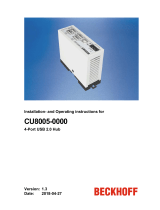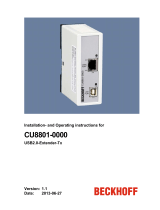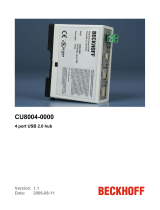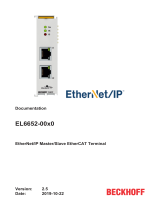Page is loading ...

Installation- and Operating instructions for
FC9001-0010, FC9011, FC9002, FC9004
FC9022, FC9062
PCI/PCIe Cards for Ethernet
Version: 2.1
Date: 2012-03-05


Table of contents
Table of contents
1 Foreword 3
1.1 Notes on the Documentation 3
1.1.1 Liability Conditions 3
1.1.2 Trademarks 3
1.1.3 Patent Pending 3
1.1.4 Copyright 3
1.1.5 Delivery conditions 3
1.2 Safety instructions 4
1.2.1 State at Delivery 4
1.2.2 Operator’s obligation to exercise diligence 4
1.3 Description of safety symbols 4
2 Product Description 5
2.1 Product Overview 5
2.1.1 FC9001-0010, FC9011, FC9022 PCI Ethernet 5
2.1.2 FC9002, FC9004 PCI Ethernet 6
2.1.3 FC9062 PCIe Modul 7
2.2 Technical data 8
2.2.1 FC9001-0010, FC9011, FC9002, FC9004 8
2.2.2 FC9022, FC9062 9
2.3 Ethernet 10
2.3.1 Basic Principles 10
3 Installation 11
3.1 Installation in the PC 11
3.2 TwinCAT driver for Ethernet cards 12
3.2.1 Driver Overview 12
3.2.2 Installation of the TwinCAT driver for real-time Ethernet 12
3.3 Driver installation using the Add New Hardware Wizard 13
3.3.1 Resources 17
3.4 Driver substitution using the TwinCAT System Manager 18
3.5 Manual driver installation 21
3.5.1 Resources 26
3.6 Activating the TwinCAT Ethernet protocol 27
3.7 Searching for devices 31
FC90xx 1

Table of contents
4 Configuration via TwinCAT System Manager 33
4.1 General tab 34
4.2 Adapter tab 35
4.2.1 Compatible Devices 36
4.3 EtherCAT tab 38
4.4 Statistics tab 39
4.5 Diagnostics tab 40
5 Appendix 41
5.1 Beckhoff Support & Service 41
5.1.1 Beckhoff branches and partner companies 41
5.1.2 Beckhoff headquarters 41
5.1.3 Beckhoff Support 41
5.1.4 Beckhoff Service 41
2 FC90xx

Foreword
1 Foreword
1.1 Notes on the Documentation
This description is only intended for the use of trained specialists in control and automation engineering
who are familiar with the applicable national standards. It is essential that the following notes and
explanations are followed when installing and commissioning these components.
The responsible staff must ensure that the application or use of the products described satisfy all the
requirements for safety, including all the relevant laws, regulations, guidelines and standards.
1.1.1 Liability Conditions
The documentation has been prepared with care. The products described are, however, constantly under
development. For that reason the documentation is not in every case checked for consistency with
performance data, standards or other characteristics. In the event that it contains technical or editorial
errors, we retain the right to make alterations at any time and without warning. No claims for the
modification of products that have already been supplied may be made on the basis of the data, diagrams
and descriptions in this documentation.
1.1.2 Trademarks
Beckhoff
®
, TwinCAT
®
, EtherCAT
®
, Safety over EtherCAT
®
, TwinSAFE
®
and XFC
®
are registered
trademarks of and licensed by Beckhoff Automation GmbH.
Other designations used in this publication may be trademarks whose use by third parties for their own
purposes could violate the rights of the owners.
1.1.3 Patent Pending
The EtherCAT Technology is covered, including but not limited to the following patent applications and
patents: EP1590927, EP1789857, DE102004044764, DE102007017835 with corresponding applications
or registrations in various other countries.
The TwinCAT Technology is covered, including but not limited to the following patent applications and
patents: EP0851348, US6167425 with corresponding applications or registrations in various other
countries.
1.1.4 Copyright
©
Beckhoff Automation GmbH.
The reproduction, distribution and utilization of this document as well as the communication of its contents
to others without express authorization are prohibited. Offenders will be held liable for the payment of
damages. All rights reserved in the event of the grant of a patent, utility model or design.
1.1.5 Delivery conditions
In addition, the general delivery conditions of the company Beckhoff Automation GmbH apply.
FC90xx 3

Foreword
1.2 Safety instructions
1.2.1 State at Delivery
All the components are supplied in particular hardware and software configurations appropriate for the
application. Modifications to hardware or software configurations other than those described in the
documentation are not permitted, and nullify the liability of Beckhoff Automation GmbH.
1.2.2 Operator’s obligation to exercise diligence
The operator must ensure that
• the product is only used as intended (see chapter Product Description)
• the product is in a sound condition and in working order during operation
• the product is operated, maintained and repaired only by suitably qualified and authorized
personnel
• the personnel is instructed regularly about relevant occupational safety and environmental
protection aspects, and is familiar with the operating manual and in particular the safety notes
contained herein
• the operation manual is in good condition and complete, and always available for reference at the
location of the product
• none of the safety and warning notes attached to product are removed, and that all notes remain
legible.
1.3 Description of safety symbols
The following safety symbols are used in this operating manual. They are intended to alert the reader to
the associated safety instructions.
Acute risk of injury!
DANGER
If you do not adhere the safety advise adjoining this symbol, there is immediate
danger to life and health of individuals!
Risk of injury!
WARNING
If you do not adhere the safety advise adjoining this symbol, there is danger to life and
health of individuals!
Hazard to individuals!
CAUTION
If you do not adhere the safety advise adjoining this symbol, there is obvious hazard to
individuals!
Hazard to devices and environment
Attention
If you do not adhere the notice adjoining this symbol, there is obvious hazard to
materials and environment.
Note or pointer
Note
This symbol indicates information that contributes to better understanding.
4 FC90xx

Product Description
2 Product Description
2.1 Product Overview
2.1.1 FC9001-0010, FC9011, FC9022 PCI Ethernet
The Ethernet PCI network cards FC9001-0010, FC9011 und FC9022 from Beckhoff save space and
costs. They can be used in office and automation networks and offer the following benefits:
• plug-and-play interface
• 10/100/1,000 Mbit/s (FC9011, FC9022), 10/100 Mbit/s (FC9001-0010), full duplex
• automatic baud rate setting according to IEEE 802.3u
• maximum performance through hardware-integrated checksum creation and verification
• The hardware side supports Quality of Service (QoS) through prioritised multiple queues.
• Wake on LAN
• Boot from LAN (PXE) (only FC9011)
Naturally, the cards (or individual channels) can also be operated with TwinCAT drivers – and therefore in
real-time.
FC90xx 5

Product Description
2.1.2 FC9002, FC9004 PCI Ethernet
Up to four Ethernet channels in one slot: The Ethernet PCI network cards from Beckhoff save space and
costs. They can be used in office and automation networks and offer the following benefits:
• plug-and-play interface
• 10/100 Mbit/s, full duplex
• automatic baud rate setting according to IEEE 802.3u for each channel
• maximum performance through hardware-integrated checksum creation and verification
• The hardware side supports Quality of Service (QoS) through prioritised multiple queues.
Naturally, the cards (or individual channels) can also be operated with TwinCAT drivers – and therefore in
real-time.
6 FC90xx

Product Description
2.1.3 FC9062 PCIe Modul
Beckhoff PCIe modules are based on a new definition of highly integrated PCI Express plug-in cards and
follow the trend towards ever smaller PCs. The function of PC plug-in cards is integrated in a compact
format that is suitable for harsh industrial environments.
The 3½-inch motherboard CB3052 offers four PCI Express lanes to be distributed to the PCIe module
slots or standard plug-in card slots. The result are PCs with module slots and/or slots for plug-in cards. A
PCIe module is connected to the motherboard via one PCI Express lane with a data transfer rate of 2
Gigabit. A module can therefore provide two Gigabit Ethernet interfaces, for example.
The FC9062 module complements the slide-in IPC C5210, the Panel PC CP62xx and the control cabinet
IPCs C6515, C6525 and C6930 with two Gigabit Ethernet ports. If two modules are used, these PCs have
a total of six Ethernet interfaces, while the PCI Express socket continues to be available for a seventh
Ethernet port or a fieldbus interface for PROFIBUS, CANopen, DeviceNet or SERCOS. If only one of the
two module slots is equipped with a PCIe module, the second slot is available for feeding motherboard
interfaces such as COM ports, USB or sound out of the PC. The connection for a Mini PCI card can also
be fed out through the module slots, even if the basic configuration of the PC, e.g. the C6515, does not
allow for Mini PCI fieldbus cards.
FC90xx 7

Product Description
2.2 Technical data
2.2.1 FC9001-0010, FC9011, FC9002, FC9004
Technical data FC9001-0010 FC9011 FC9002 FC9004
Bus system Ethernet (all Ethernet (IEEE 802.3) based protocols)
Number of Ethernet channels 1 1 2 4
Ethernet Interface 10BASE-T/
100BASE-TX
10BASE-T/
100BASE-TX/
1000BASE-TX
10BASE-T/ 100BASE-TX
Ethernet sockets 1 x RJ45 2 x RJ45 4 x RJ45
Cable length maximum 100 m up to Hub, Switch or end device
Baud rate 10/100 MBit/s
IEEE 802.3u
auto-negotiation,
full duplex at 10 or
100 MBit/s
10/100/1000 MBit/s
IEEE 802.3ab
auto-negotiation,
full duplex at
10/100/1000 MBit/s
10/100 MBit/s
IEEE 802.3u auto-negotiation,
full duplex at 10 or 100 MBit/s, separate
settings for each channel
Diagnose 2 LEDs per channel:
- Link/ Speed (Green = 100MBit/ Orange = 1GBit)
- Activity
Interface to the PC 32 Bit Plug-and-Play PCI-Interface
Standard driver standard operating system drivers for
Intel-compatible NIC
Standard driver for Intel 8255xER series
or Beckhoff driver for Windows 2000/XP
(Drivers can be selected separately for
each channel)
Real time driver TwinCAT driver for real time Ethernet
Supply voltage (PCI-Bus) 5 V
Current consumption typ. (PCI-
Bus, 5 V)
200 mA 350 mA 800 mA 1200 mA
Weight 45 g 45 g 75 g 95 g
Dimensions (B x H x T, without
slot plate)
18 x 45 x 120 18 x 95 x 125
Permissible ambient
temperature range during
operation
0°C ... + 55°C
Permissible ambient
temperature range during
storage
-25°C ... + 85°C
Permissible relative humidity 95%, no condensation
Vibration / shock resistance according to EN 60068-2-6 / EN 60068-2-27, EN 60068-2-29
EMC resistance burst / ESD according to EN 61000-6-2 / EN 61000-6-4
Installation position variable
Approval CE
8 FC90xx

Product Description
2.2.2 FC9022, FC9062
Technical data FC9022 FC9062
Bus system Ethernet (all Ethernet (IEEE 802.3) based protocols)
Number of Ethernet channels 2
Ethernet Interface 10BASE-T / 100BASE-TX/ 1000BASE-TX
Ethernet sockets 2 x RJ45
Cable length maximum 100 m up to Hub, Switch or end device
Baud rate 10/100 MBit/s, IEEE 802.3ab auto-negotiation,
full duplex at 10, 100 or 1000 MBit/s, separate settings for each channel
Diagnose 2 LEDs per channel:
- Link/ Speed (Green = 100MBit/ Orange = 1GBit)
- Activity
Interface to the PC 1x PCIe-Interface Plug-And-Play
Standard driver Standard driver for Intel 82574L series or Beckhoff driver for Windows
2000/XP/Win7 (Drivers can be selected separately for each channel)
Real time driver TwinCAT driver for real time Ethernet
Supply voltage 3,3 V
Current consumption 800 mA typical
weight 55 g 45 g
Dimensions (B x H x T, without
slot plate)
18 x 62 x 100 18 x 46 x 91
Permissible ambient
temperature range during
operation
0°C ... + 55°C
Permissible ambient
temperature range during
storage
-25°C ... + 85°C
Permissible relative humidity 95%, no condensation
Vibration / shock resistance according to EN 60068-2-6 / EN 60068-2-27, EN 60068-2-29
EMC resistance burst / ESD according to EN 61000-6-2 / EN 61000-6-4
Installation position variable
Approval CE
FC90xx 9

Product Description
2.3 Ethernet
Ethernet was originally developed by DEC, Intel and XEROX (as the "DIX" standard) for passing data
between office devices. The term nowadays generally refers to the IEEE 802.3 CSMA/CD specification,
published in 1985. Because of the high acceptance around the world this technology is available
everywhere and is very economical. This means that it is easy to make connections to existing networks.
There are now a number of quite different transmission media: coaxial cable (10Base5), optical fiber
(10BaseF) or twisted pairs (10BaseT) with screen (STP) or without screen (UTP). A variety of topologies
such as ring, line or star can be constructed with Ethernet.
Ethernet transmits Ethernet packets from a sender to one or more receivers. This transmission takes
place without acknowledgement, and without the repetition of lost packets. To achieve reliable data
communication, there are protocols, such as TCP/IP, that can run on top of Ethernet.
2.3.1 Basic Principles
2.3.1.1 The Internet Protocol (IP)
The internet protocol (IP) forms the basis of this data communication. IP transports data packets from one
device to another; the devices can be in the same network, or in different networks. IP here looks after
the address management (finding and assigning MAC-IDs), segmentation and routing. Like the Ethernet
protocol, IP does not guarantee that the data is transported - data packets can be lost, or their sequence
can be changed.
TCP/IP was developed to provide standardized, reliable data exchange between any number of different
networks. TCP/IP is thus substantially independent of the hardware or software being used. Although the
term is often used as if it were a single concept, a number of protocols are layered together: e.g. IP, TCP,
UDP, ARP and ICMP.
2.3.1.2 Transmission Control Protocol (TCP)
The Transmission Control Protocol (TCP) which runs on top of IP is a connection-oriented transport
protocol. It includes error detection and error handling mechanisms. Lost telegrams are repeated.
2.3.1.3 User Datagram Protocol (UDP)
UDP is connectionless transport protocol. It provides no control mechanism when exchanging data
between sender and receiver. This results in a higher processing speed than, for example, TCP.
Checking whether or not the telegram has arrived must be carried out by the higher-level protocol.
2.3.1.4 Internet Control Message Protocol (ICMP)
It is used by end devices, to exchange information about the current status of the internet protocol.
2.3.1.5 Address Resolution Protocol (ARP)
Performs conversion between the IP addresses and MAC addresses.
2.3.1.6 BootP
The BootP protocol allows the TCP/IP address to be set or altered, by addressing the network device with
its MAC-ID.
10 FC90xx

Installation
3 Installation
3.1 Installation in the PC
Follow the usual ESD guidelines
Warning
The Ethernet cards are supplied in ESD packaging. Follow the usual ESD guidelines
for handling PC cards during installation!
1. Before installing the Ethernet card, switch off the PC and any external power supplies, and
separate the PC from the mains.
2. Open the PC case.
3. For a free PCI slot on the motherboard, remove the metal plate in the PC case.
4. Insert the Ethernet card into the free PCI slot and fix it with the screw or device provided.
Ensure that there is sufficient space between the Ethernet card and other PC components, so
that the Ethernet card cannot come into contact with other plug-in cards or memory components
etc.
5. Close the PC case.
6. Connect the Ethernet cables with the optical fibre connections of the Ethernet card.
7. Connect the PC to the mains and switch it on.
8. The Ethernet card will be detected as new hardware when the operating system starts up. Follow
the assistant's instructions for installing the Ethernet card driver.
9. If you wish to use the TwinCAT driver for real-time Ethernet and EtherCAT, you should now
- install TwinCAT
- install or modify the driver.
The Ethernet card does not require an external power supply. It is supplied directly from the PC via the
PCI bus. The power supply of the PC has to be adequate for meeting the power requirement of the
Ethernet cards, particularly if several Ethernet cards are installed.
FC90xx 11

Installation
3.2 TwinCAT driver for Ethernet cards
First install Software
Note
Install the Beckhoff TwinCAT automation software before installing the Beckhoff
Ethernet card.
3.2.1 Driver Overview
TwinCAT delivers two different drivers for Ethernet cards:
• TwinCAT driver for real-time Ethernet
• TwinCAT RT-Ethernet Intermediate Driver.
TwinCAT driver for real-time Ethernet
The TwinCAT driver for real-time Ethernet works only for Ethernet cards with Intel chipset!
It supports hard real time for Beckhoff Real Time Ethernet and EtherCAT applications.
TwinCAT RT-Ethernet Intermediate Driver
The TwinCAT RT-Ethernet Intermediate Driver works also with other network cards that have no Intel
chip set,
It is an evaluation driver for laboratory and test operation, to be able to test TwinCAT also with other
network cards that have no Intel chip set.
It supports no hard real time and may cause jitter!
Further information about TwinCAT RT-Ethernet Intermediate Driver may be found in the TwinCAT
Information System.
3.2.2 Installation of the TwinCAT driver for real-time Ethernet
There are three ways to install the TwinCAT driver for real-time Ethernet on your PC.
• Driver installation using the Add New Hardware Wizard:
This is the usual way to install hardware drivers.
• Driver substitution via the TwinCAT System Manager:
If your operating system installed its own driver for the Beckhoff Intel PCI/Ethernet card, you can
substitute this driver by the TwinCAT driver for real-time Ethernet manually in order to be able to
take advantage of its real-time capability.
• Manual driver installation:
If your operating system installed its own driver for the Beckhoff Intel PCI/Ethernet card, you can
substitute the TwinCAT driver for real-time Ethernet manually in order to be able to take
advantage of its real-time capability.
12 FC90xx

Installation
3.3 Driver installation using the Add New Hardware Wizard
First install Software
Note
Install the Beckhoff TwinCAT automation software before installing the Beckhoff
Ethernet card.
Installation under Windows 2000 and Windows XP
Note
All screen shots of this documentation are made under Windows 2000.
Under Windows XP, the TwinCAT driver is installed in the same way.
After installation of the Beckhoff Ethernet card, Windows 2000, for example, comes up with the following
message during start-up:
Follow the instructions of the Add Hardware Wizard.
FC90xx 13

Installation
Allow the assistant to search for a suitable driver.
The TwinCAT driver for real-time Ethernet is included with the Beckhoff TwinCAT automation software.
14 FC90xx

Installation
If you have installed the Beckhoff TwinCAT automation software before installing the Beckhoff Ethernet
card, the Add New Hardware Wizard will find the TwinCAT driver for real-time Ethernet in the driver
database on the hard disk of your PC.
Operation of the TwinCAT drivers for real-time Ethernet requires no digital signature from Microsoft.
Beckhoff has thoroughly tested this driver in conjunction with the supported hardware and has verified
compatibility with Windows 2000 and XP.
Click Yes to continue with the rest of the installation.
FC90xx 15

Installation
The TwinCAT driver for real-time Ethernet was installed successfully for an Ethernet port. Exit the
installation with Finish.
If you are using a multi-channel Beckhoff Ethernet card, repeat the driver installation procedure for each
additional channel:
16 FC90xx

Installation
Now you have to activate the TwinCAT Ethernet Protocol (see chapter Activating the TwinCAT Ethernet
protocol).
3.3.1 Resources
Example for the resources of an FC900x under Windows 2000
(Control Panel/System/Hardware/Device Manager/Network adapters/TwinCAT Intel PCI-Ethernet
adapter/Resources):
FC90xx 17

Installation
3.4 Driver substitution using the TwinCAT System Manager
First install Software
Note
Install the Beckhoff TwinCAT automation software before installing the Beckhoff
Ethernet card.
Installation under Windows 2000 and Windows XP
Note
All screen shots of this documentation are made under Windows 2000.
Under Windows XP, the TwinCAT driver is installed in the same way.
Click t al the right bottom side of the Windows taskbar on the TwinCAT icon and start the TwinCAT
System-Manger.
Click on Show Real Time Ethernet Compatible Devices in the Options menu.
Now the TwinCAT System Manager shows the real time capable (Compatible devices) and non real time
capable (Incompatible devices) network cards.
18 FC90xx
/








